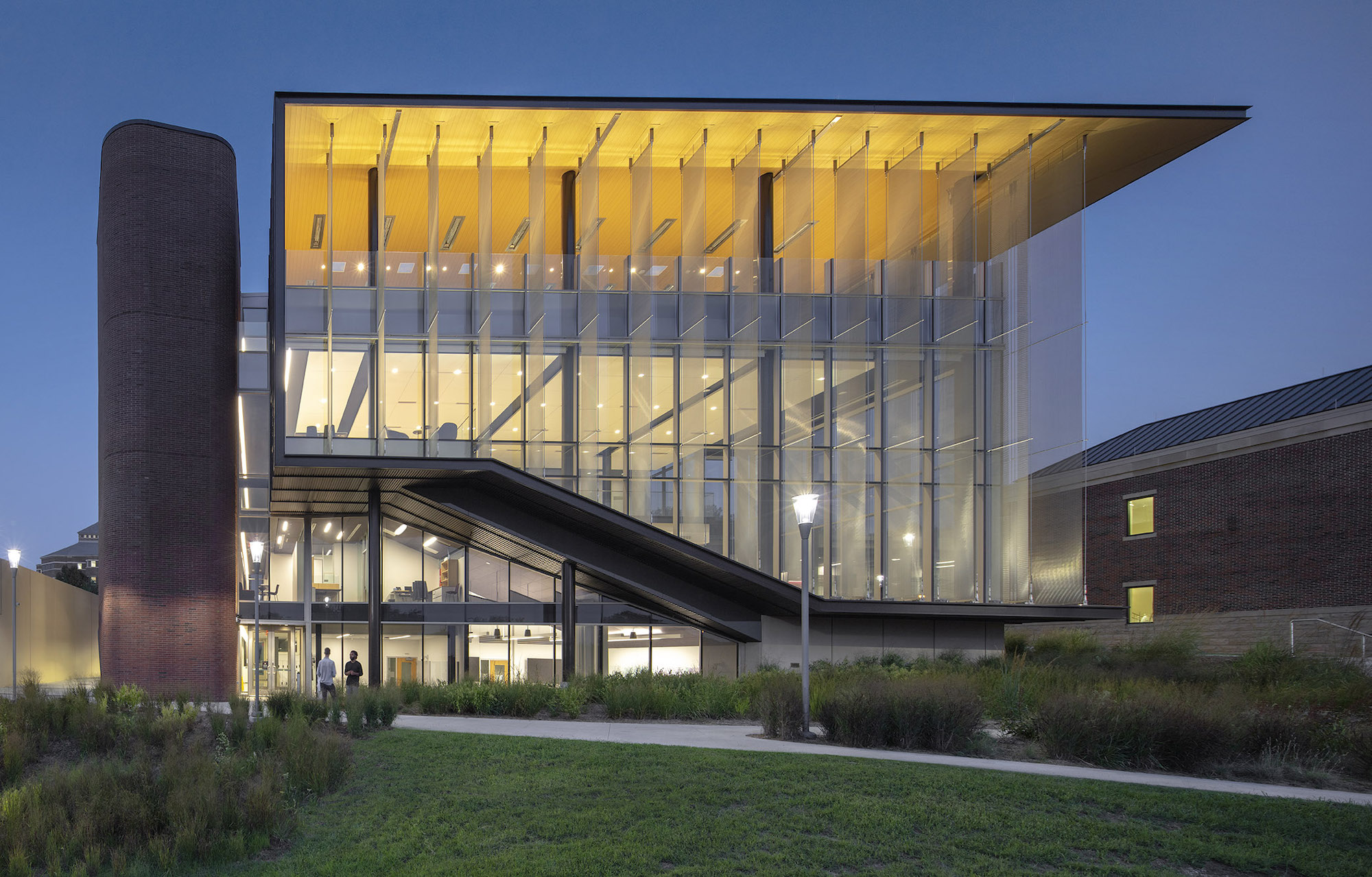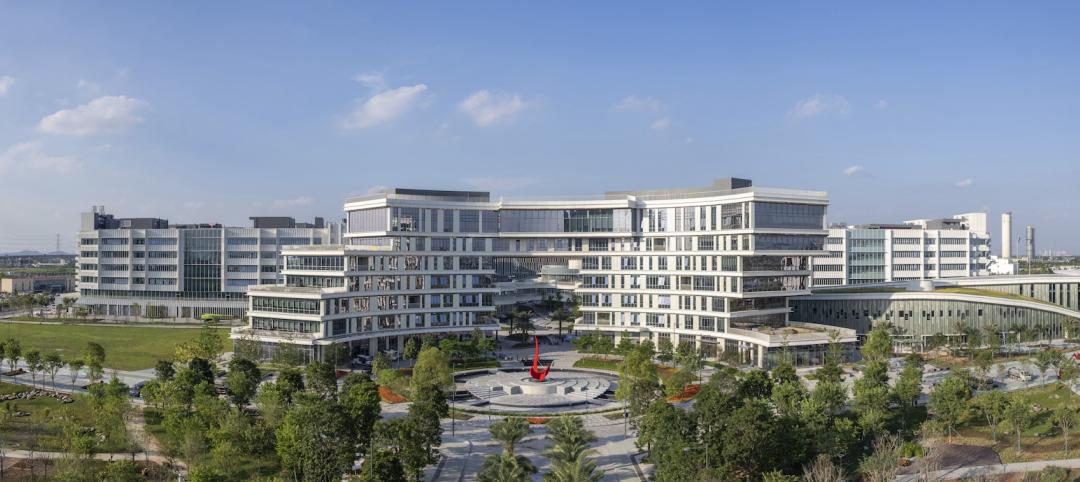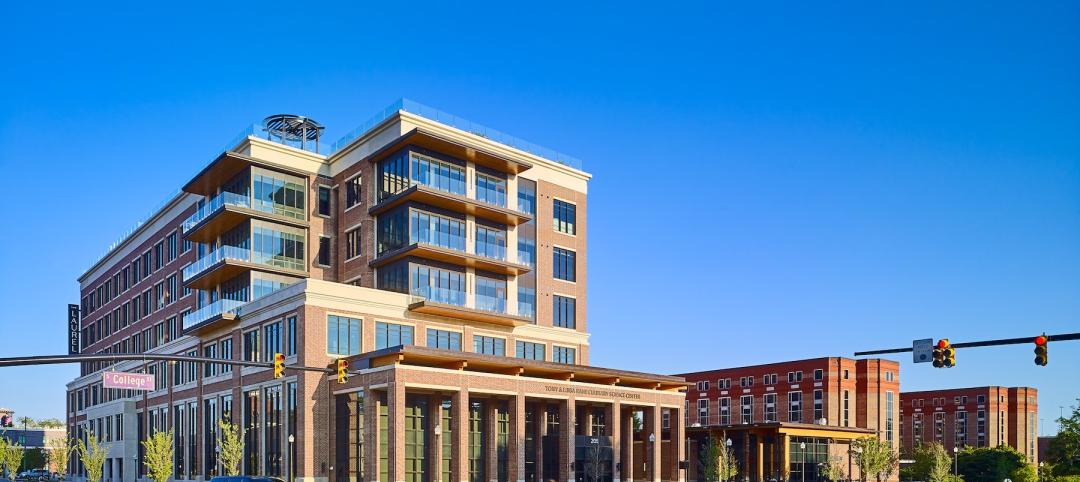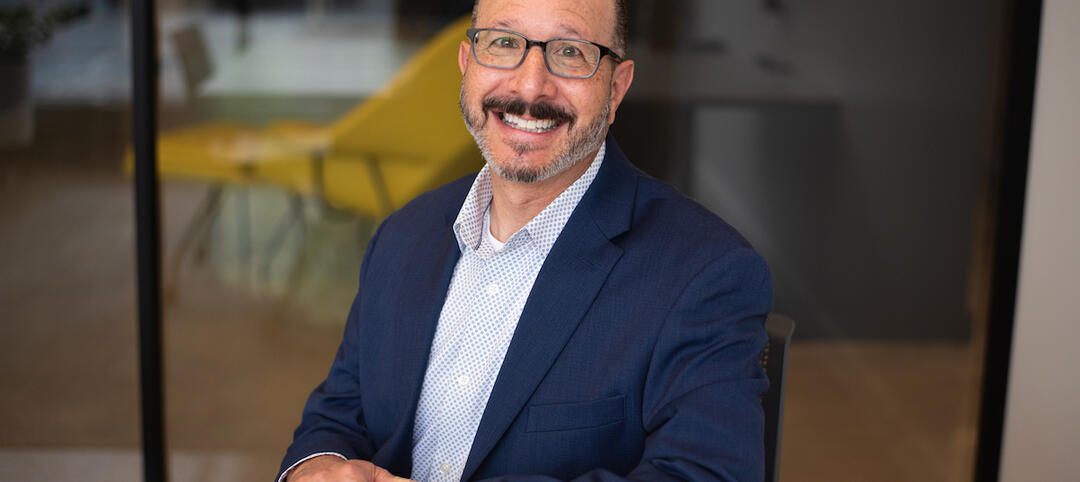The Center for Medical Education Innovation (CMEI) at Kansas City University was designed to adapt to changes in medical curriculum and pedagogy. The project program supported the mission of training leaders in osteopathic medicine with a state-of-the-art facility that leverages active-learning and simulation-based training.
The four-story, 56,000-sf medical education facility and an adjacent two-level free-standing parking structure were designed with key themes of transparency and multi functionality. The building consists of about 26,000 sf of assignable medical education space and an additional 9,500 sf of shelled classroom space.
The CMEI helps define a new campus entry and lower quad. The pavilion-like four-story building takes advantage of the site’s sloping topography while maintaining the scale of the existing campus by lowering one floor into the sloping site. This approach creates the illusion of a three-story structure on the campus quad.
Users are introduced to the building through the connective, multi-level, 3,000 sf lobby that doubles as a public forum to provide waiting, colloquia, study, and briefing functions. The raked, glazed two-story lobby and third-floor terrace appear to hover over the ground plane to offer a panoramic view of downtown Kansas City. The pavilion is wrapped with a single folding-plane gesture, which begins at the articulated lobby floor, bends upward to form the north wall, and crests to create a dramatically extended roof to help shade the south-facing glass elevation.
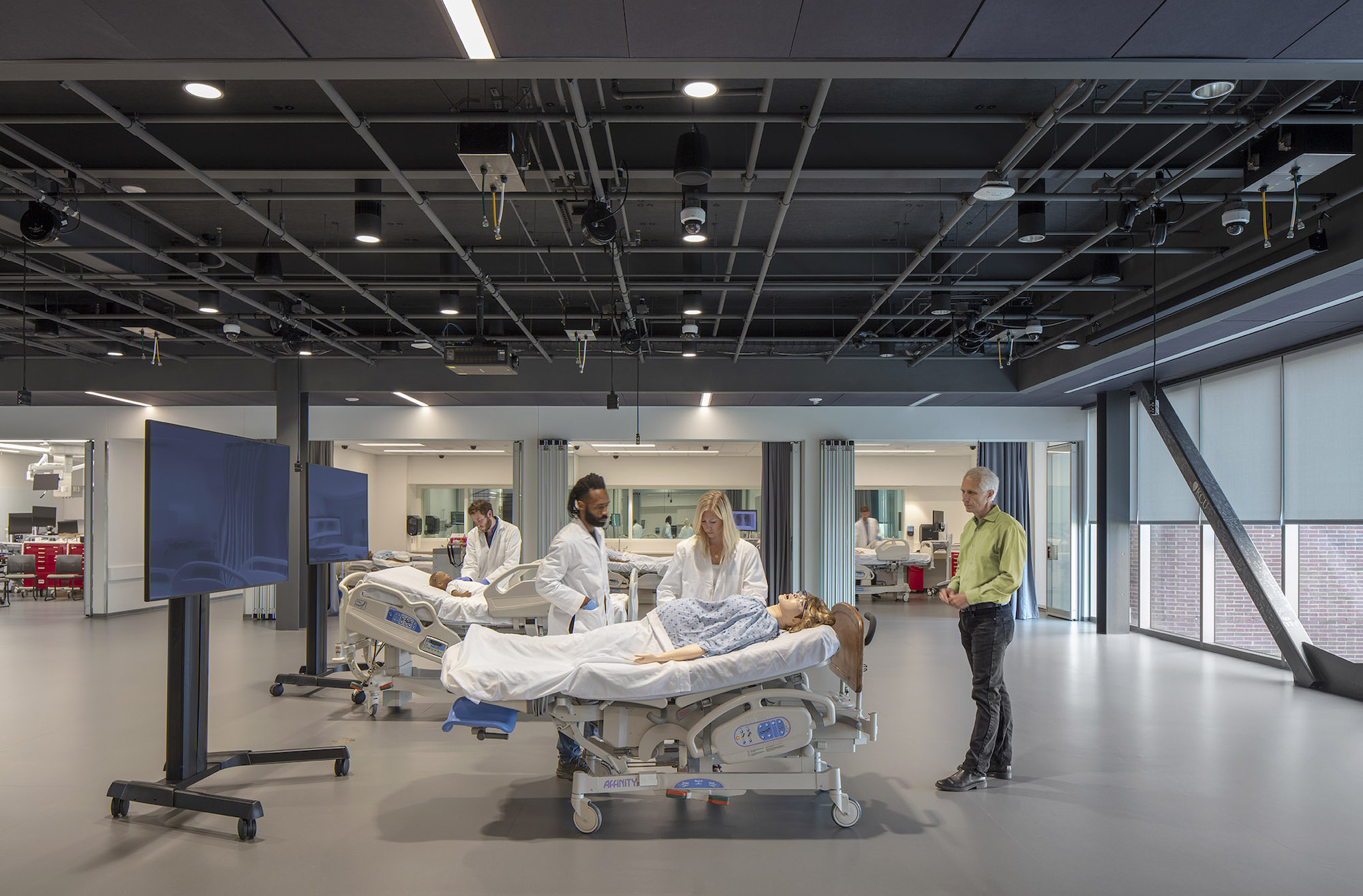
Transparency guided the articulation of the glass curtain wall to showcase the next-generation medical education environments within. The glazing defines the visually open facility, highlighting its learning activities during the day, and transforming into a subtle, illuminated beacon on campus at night. Evoking the heritage of the campus’ brick-clad buildings, the materials palette is rounded out with low-maintenance brick, metal panel, and precast concrete.
The building can adapt to changes in medical curriculum and pedagogy with a 2,800 sf simulation deck, clinical skills suite with 22 mock exam rooms, a 6,500 sf osteopathic manipulative medicine lab, and multi‐use forum that support multiple functions. The simulation suite houses an innovative and adaptable “black box” stage that can accommodate small-scale scenarios as well as large trauma events. The open ceiling utilizes a theater grid of steel tubes to supply air, vacuum, electricity, and data for simulation use, as well as hanging lights and simulation equipment that can be freely arranged throughout the space.
Situating the simulation suite at grade with its 40-foot opening to the exterior enables the space to expand onto the adjacent campus quad. Operable walls along exam rooms allow the standardized patient lounge to flex as a health assessment lab or serve as an after-hours student study space.
On the project team:
Owner and/or developer: Kansas City University of Medicine and Biosciences
Design architect: CO Architects
Architect of record: Helix Architecture + Design
MEP engineer (and lighting): Henderson Engineers
Structural (and civil) engineer: Walter P Moore
Acoustical, AV/IT Design: The Sextant Group (now NV5)
Landscape: Confluence
General contractor/construction manager: JE Dunn Construction
KCUMB Video from CO Architects on Vimeo.
A vision of the future of medical education buildings
Here is the design statement from architect CO Architects:
The Center for Medical Education Innovation (CMEI) project for Kansas City University of Medicine and Biosciences (KCU) in Kansas City, MO, is the first of a new generation of buildings at KCU aimed at fostering growth within the ever-evolving field of osteopathic medical education. Designed by CO Architects in collaboration with Helix Architecture + Design, the $33-million CMEI has an iconic design that bridges KCU’s history and traditions with its forward-looking role as a leader in osteopathic medicine.
Sited on approximately 4.5 acres of previously undeveloped green space on the west edge of campus, the CMEI helps define a new campus entry and Lower Quad. The pavilion-like four-story building takes advantage of the site’s sloping topography while maintaining the scale of the existing campus by lowering one floor into the sloping site, creating the illusion of a three-story structure on the campus quad.
Users are introduced to the building through the connective, multi-level, multi-functional, 3,000-square-foot lobby that doubles as a public forum to provide waiting, colloquia, study, and briefing functions. The raked, glazed two-story lobby and third-floor terrace appear to hover over the ground plane to offer a panoramic view of downtown Kansas City, thereby visually connecting the university with the city to emphasize KCU’s mission of improving the well-being of the larger community. The pavilion is wrapped with a single folding-plane gesture, which begins at the articulated lobby floor, bends upward to form the north wall, and then crests to create a dramatically extended roof to help shade the south-facing glass elevation.
Transparency is a key element of the design of the CMEI, guiding the articulation of the glass curtain wall to showcase the next-generation medical education environments within. The glazing defines the visually open facility, highlighting its learning activities during the day, and transforming into a subtle, illuminated beacon on campus at night. The building is a dramatic anchor to a future new campus entry. Evoking the heritage of the campus’ brick-clad buildings, the materials palette is rounded out with low-maintenance brick, metal panel, and precast concrete.
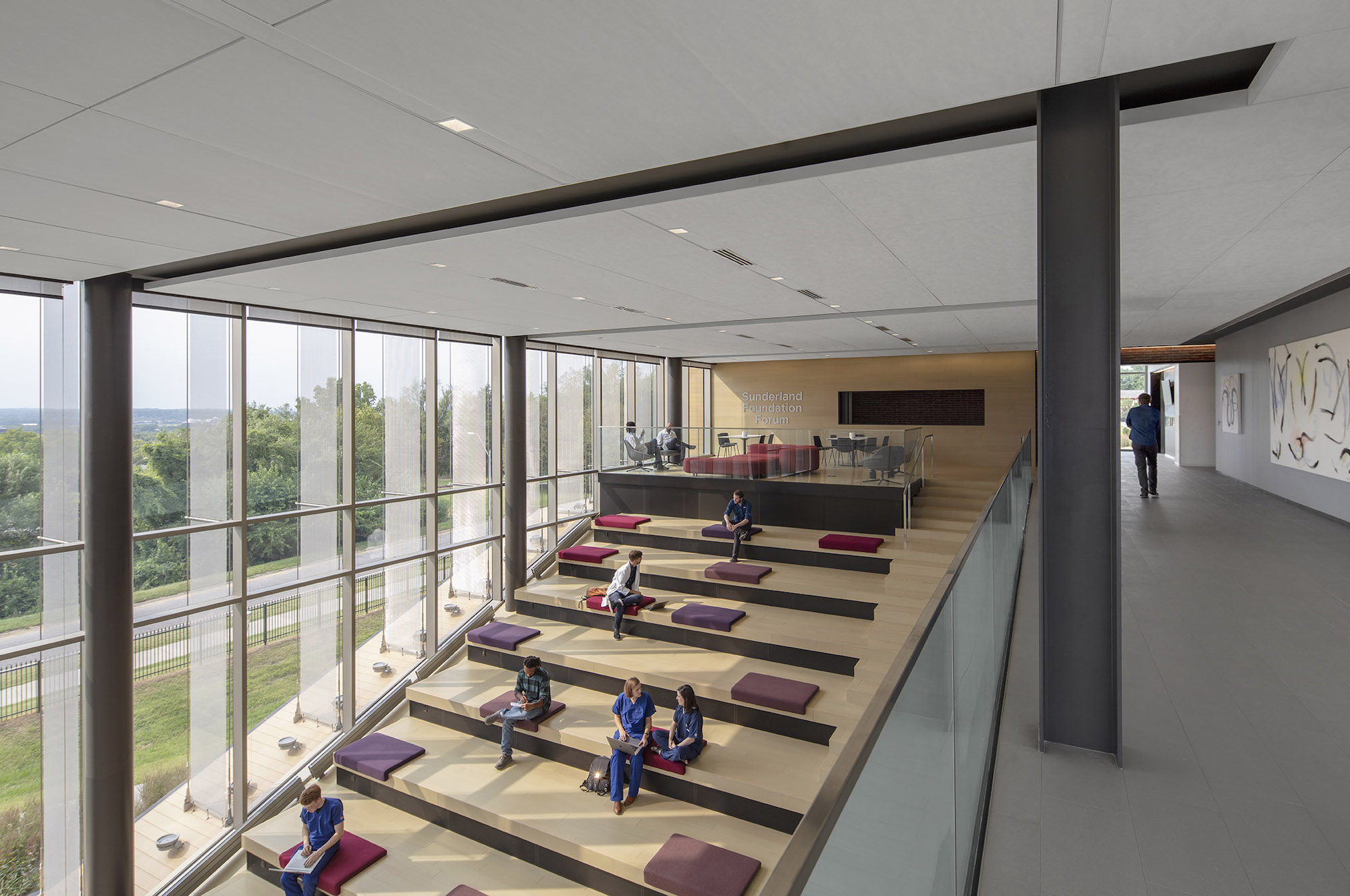
Paramount to the success of the project is the building’s ability to adapt to changes in medical curriculum and pedagogy, and for the programed spaces—a 2,800-square-foot simulation deck, clinical skills suite with 22 mock exam rooms, 6,500-square-foot osteopathic manipulative medicine lab, and multi‐use forum—to support multiple functions. The simulation suite houses an innovative and adaptable “black box” stage that can accommodate small-scale scenarios as well as large trauma events.
The open ceiling above utilizes a theater grid of steel tubes to supply air, vacuum, electricity, and data for simulation use, as well as hanging lights and simulation equipment that can be freely arranged throughout the space. Situating the simulation suite at grade with its 40-foot opening to the exterior enables the space to expand onto the adjacent campus quad. Operable walls along exam rooms allow the standardized patient lounge to flex as a health assessment lab, or serve as an after-hours student study space.
The design of the CMEI, which is LEED certified, addresses sustainability from multiple fronts. The building form was conceived to strengthen performance: It is oriented lengthwise in the east/west direction, so solar heat gain is easier to control on the longer north and south façades. The broad, 24-foot-deep cantilevered roof fully shades the south façade during the summer. Brick construction on the east façade blocks harsh early morning sunlight, and semi-transparent metal-mesh fins on the west side shade the glazing while maintaining the impressive views of the Kansas City skyline. The metal-mesh system, which features a horizontal pattern at 50% opacity, attaches to the building via ultra-thin cable rail, which allowed the design team to meet challenging wind-load requirements.
CMEI supports the University’s educational mission to train compassionate and competent leaders in osteopathic medicine by creating a state-of-the-art facility that leverages active-learning and simulation-based training. Through its sensitive yet bold architectural design—with the key themes of transparency and multi functionality—the building reflects both the University’s heritage and tradition as well as its vision for the future of medical education and community engagement.
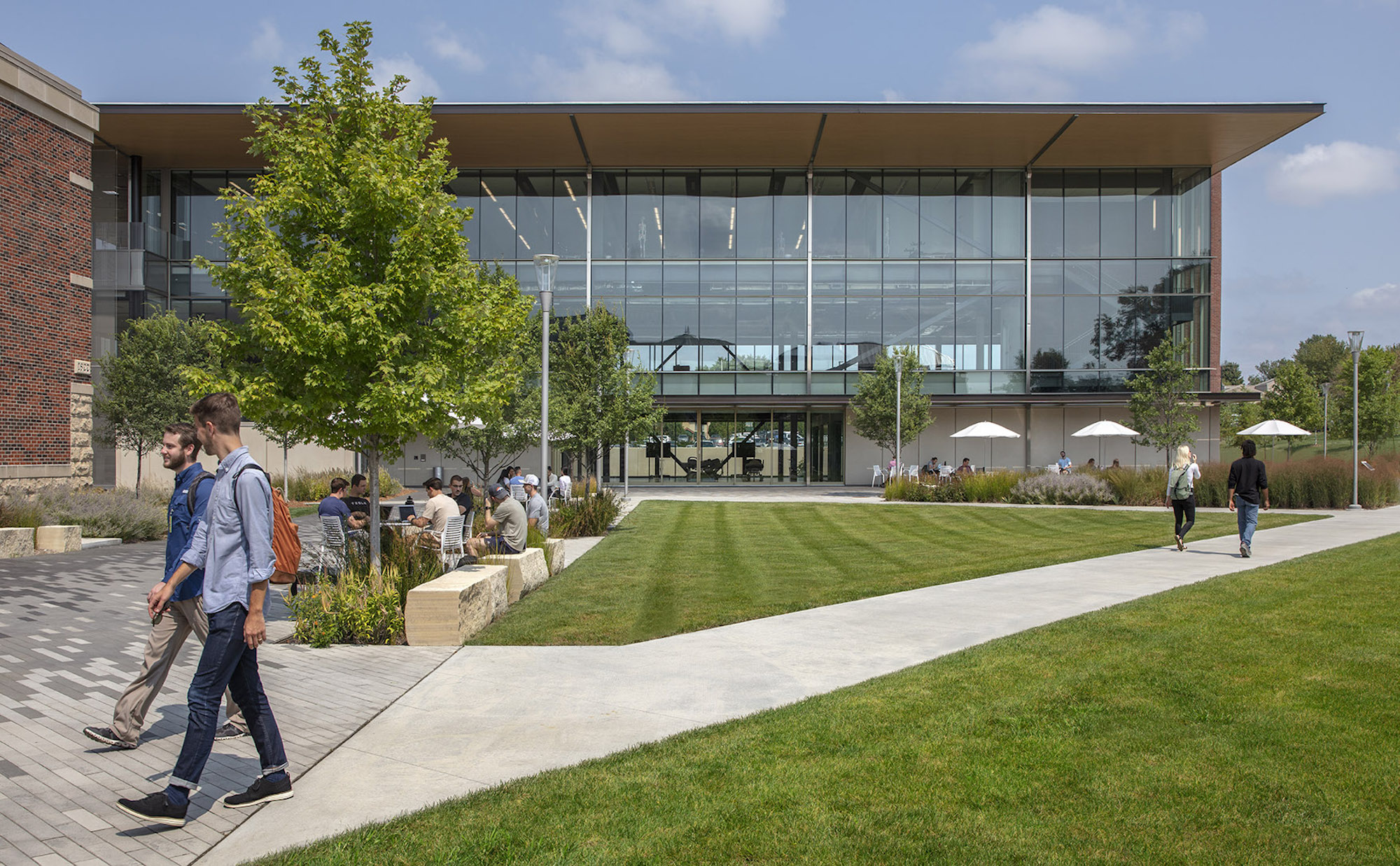
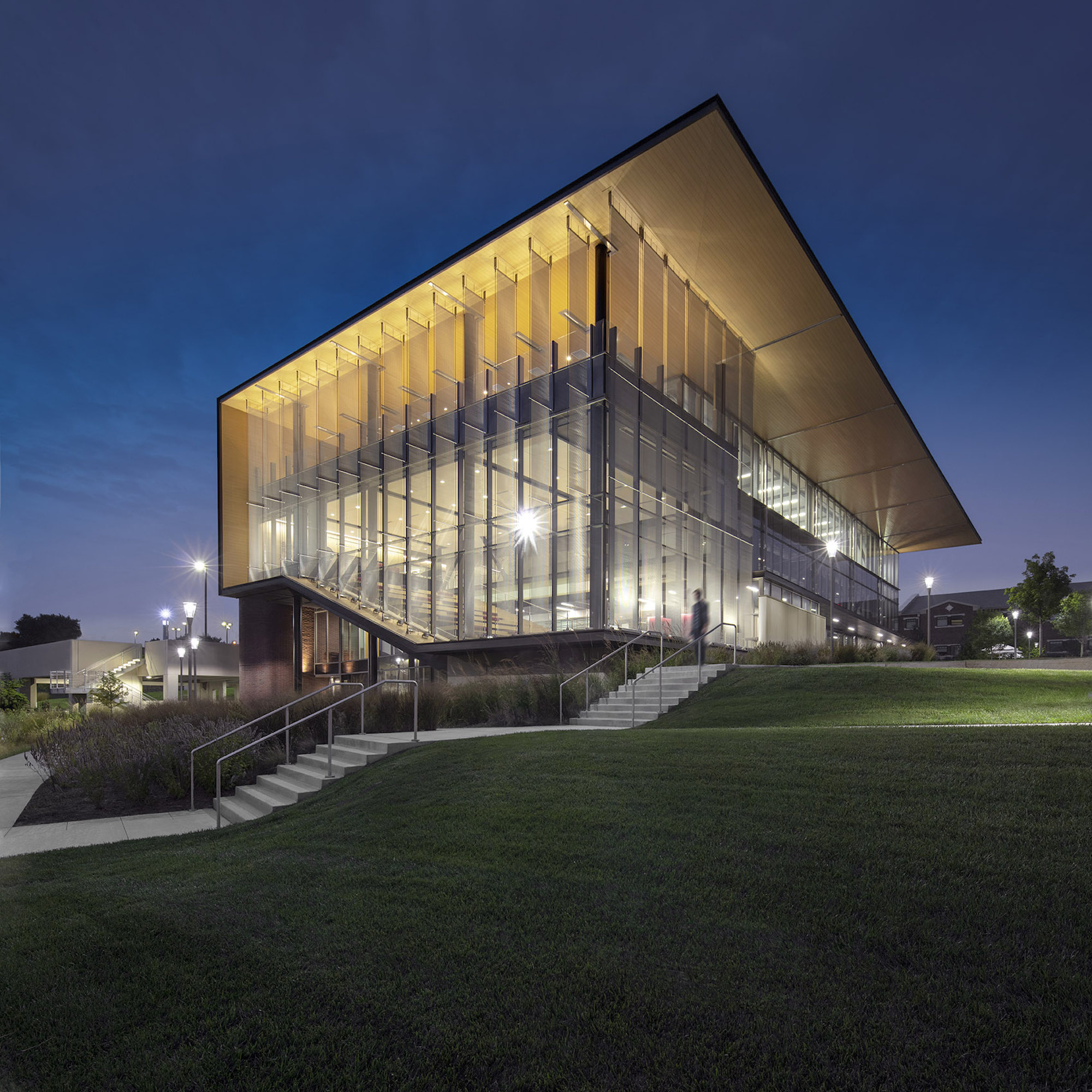
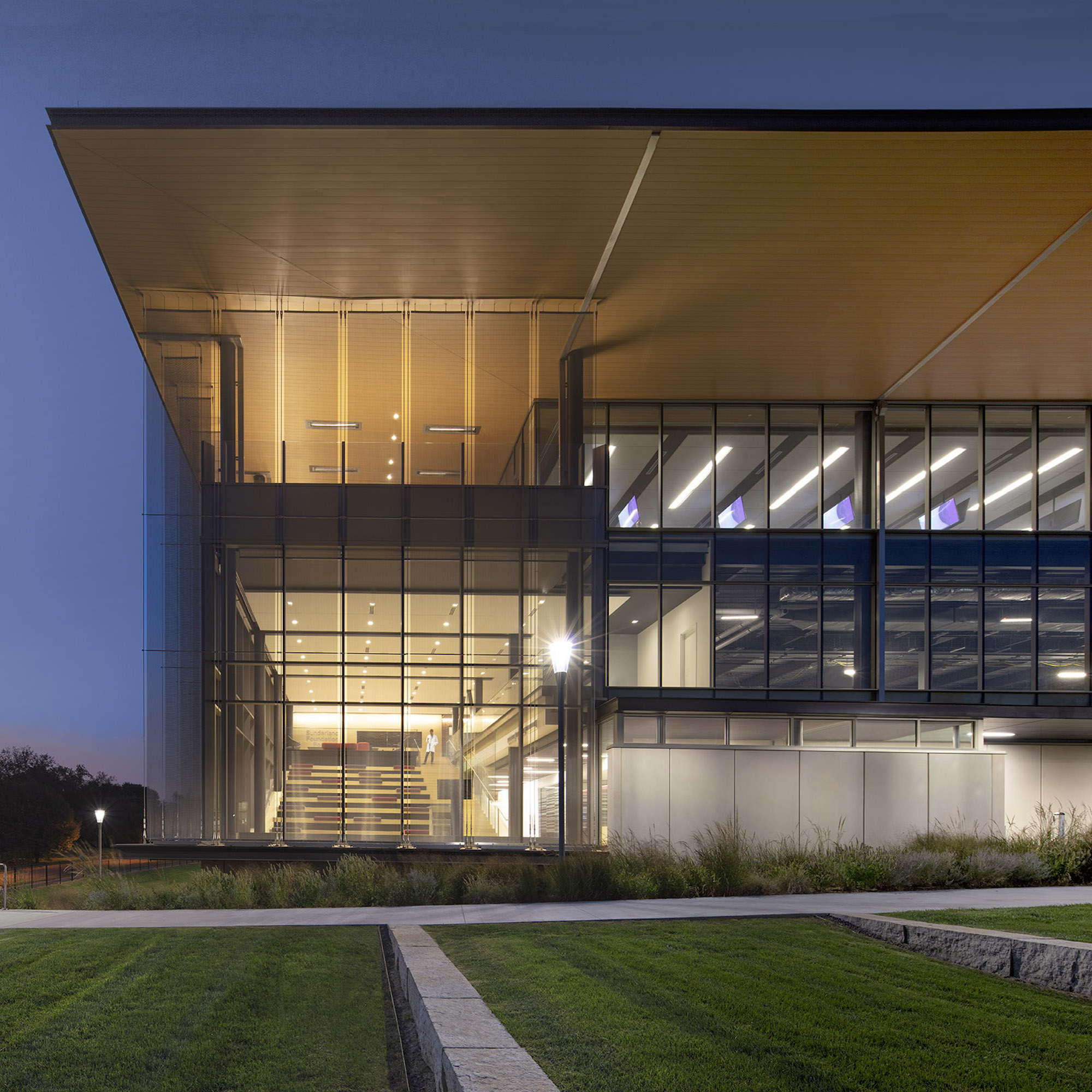
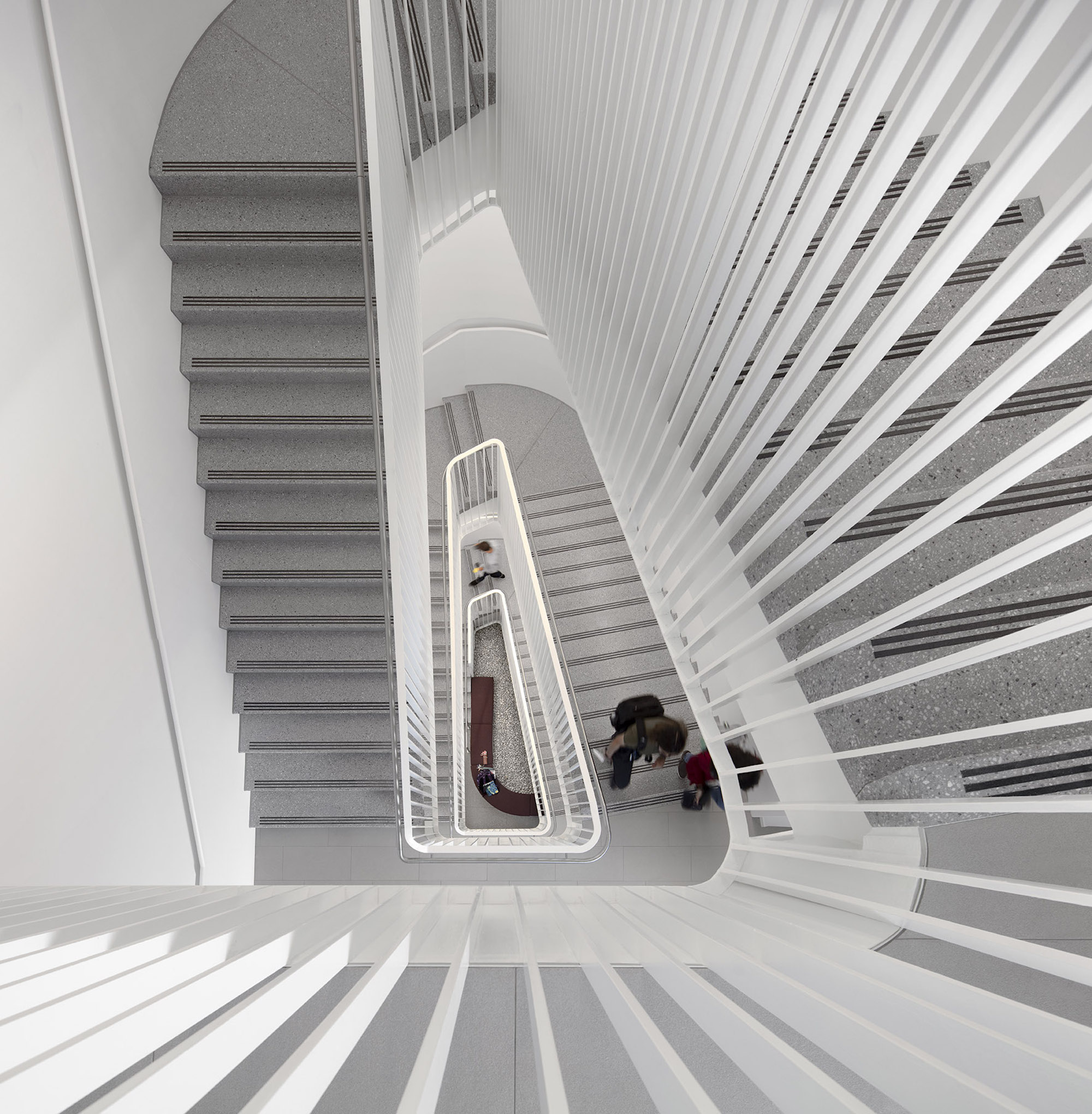
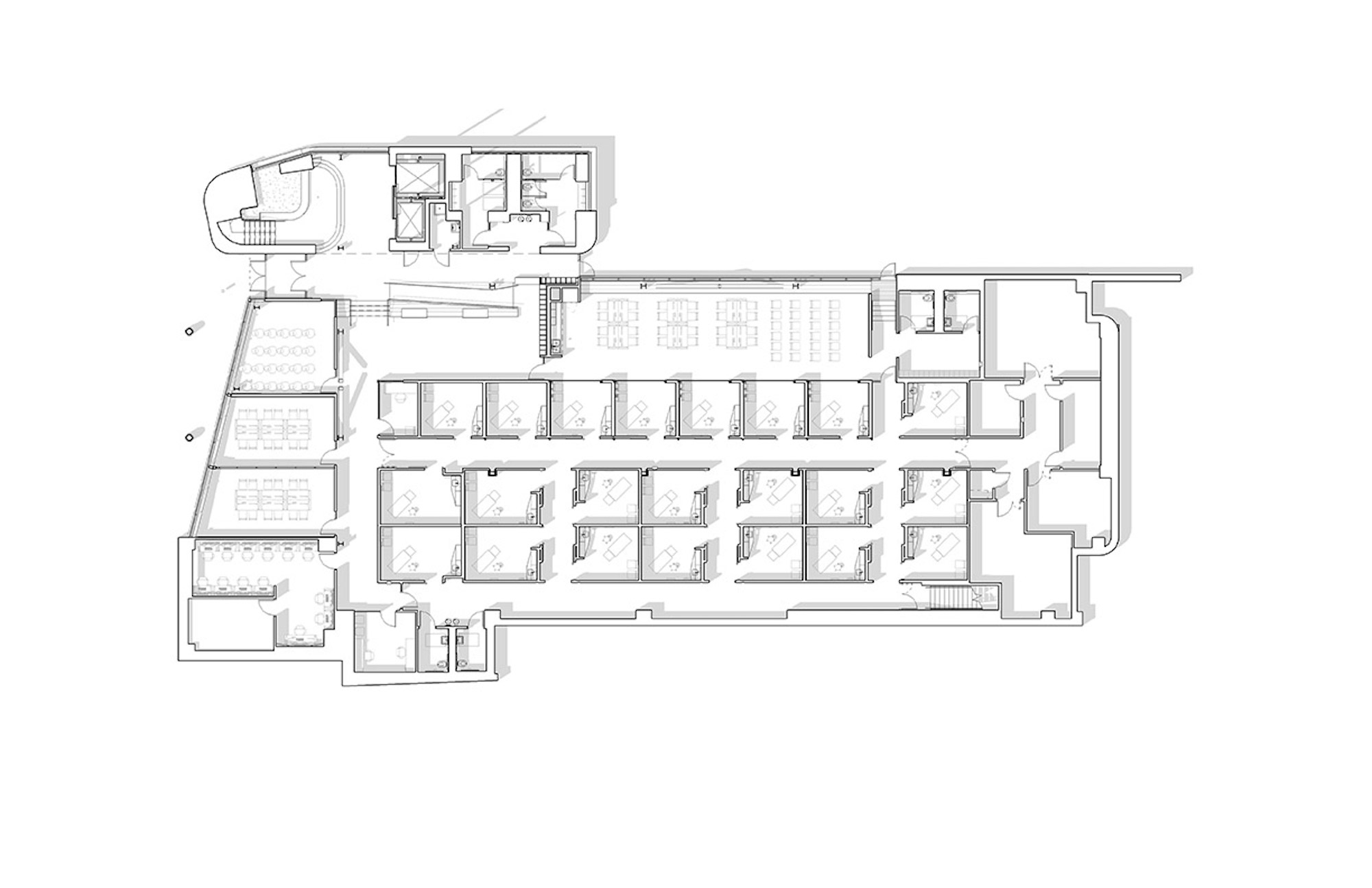
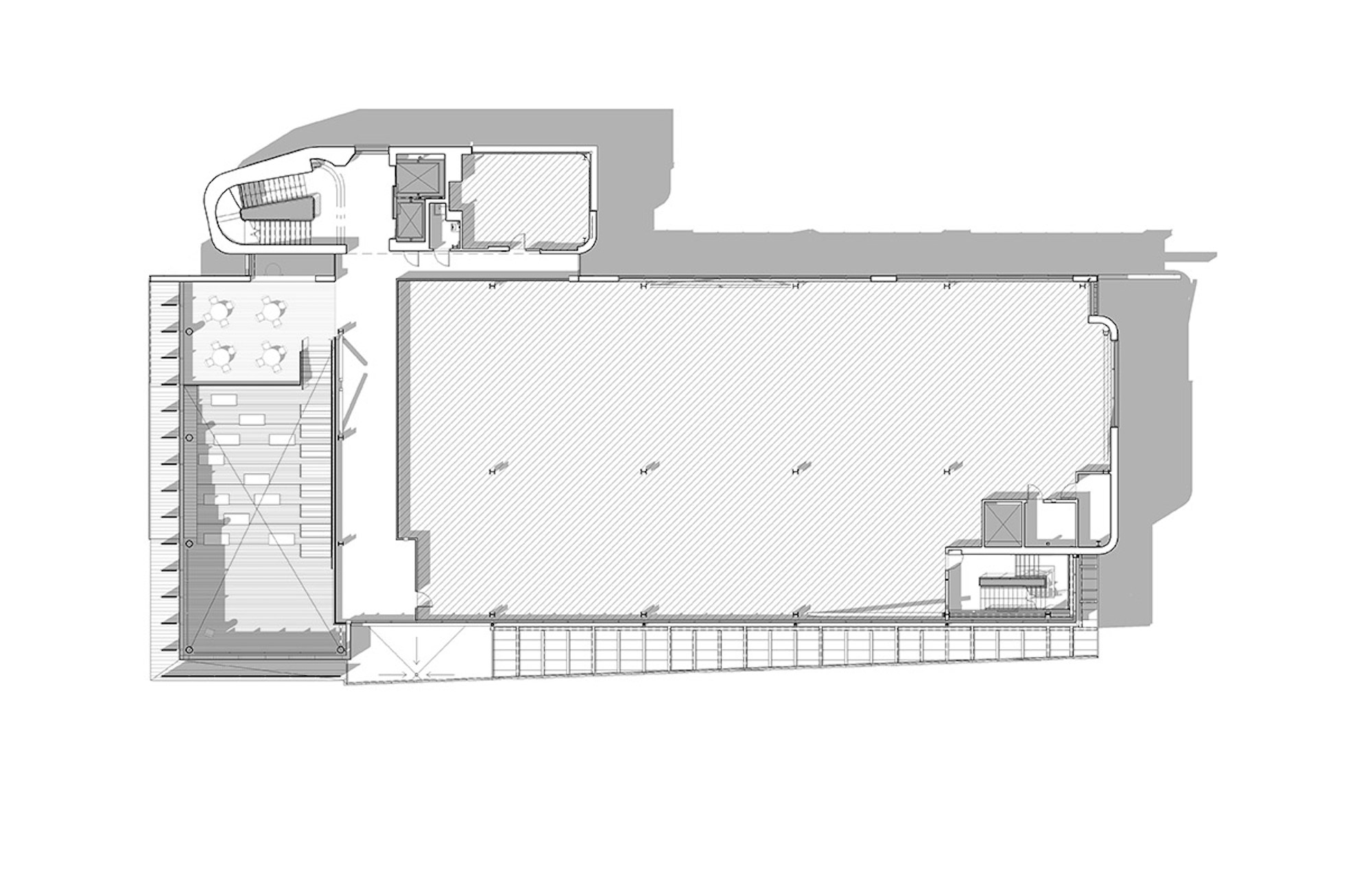
Related Stories
University Buildings | Nov 2, 2022
New Univ. of Calif. Riverside business school building will support hybrid learning
A design-build partnership of Moore Ruble Yudell and McCarthy Building Companies will collaborate on a new business school building at the University of California at Riverside.
School Construction | Oct 31, 2022
Claremont McKenna College science center will foster integrated disciplinary research
The design of the Robert Day Sciences Center at Claremont McKenna College will support “a powerful, multi-disciplinary, computational approach to the grand socio-scientific challenges and opportunities of our time—gene, brain, and climate,” says Hiram E. Chodosh, college president.
University Buildings | Oct 27, 2022
The Collaboratory Building will expand the University of Florida’s School of Design, Construction, and Planning
Design firm Brooks + Scarpa recently broke ground on a new addition to the University of Florida’s School of Design, Construction, and Planning (DCP).
Higher Education | Oct 24, 2022
Wellesley College science complex modernizes facility while preserving architectural heritage
A recently completed expansion and renovation of Wellesley College’s science complex yielded a modernized structure for 21st century STEM education while preserving important historical features.
BAS and Security | Oct 19, 2022
The biggest cybersecurity threats in commercial real estate, and how to mitigate them
Coleman Wolf, Senior Security Systems Consultant with global engineering firm ESD, outlines the top-three cybersecurity threats to commercial and institutional building owners and property managers, and offers advice on how to deter and defend against hackers.
University Buildings | Oct 18, 2022
A carbon-neutral-ready university campus opens in Hong Kong
In early September, the Hong Kong University of Science and Technology (HKUST) officially opened its new, KPF-designed campus in Nansha, Guangzhou (GZ).
University Buildings | Oct 7, 2022
Auburn’s new culinary center provides real-world education
The six-story building integrates academic and revenue-generating elements.
| Sep 14, 2022
Indian tribe’s new educational campus supports culturally appropriate education
The Kenaitze Indian Tribe recently opened the Kahtnuht’ana Duhdeldiht Campus (Kenai River People’s Learning Place), a new education center in Kenai, Alaska.
University Buildings | Sep 9, 2022
Alan Schlossberg, AIA, LEED AP, joins DesignGroup’s Pittsburgh studio as Regional Practice Leader
Alan Schlossberg, AIA, LEED AP, has joined DesignGroup as a principal of the firm and regional practice leader.
| Sep 2, 2022
New UMass Medical School building enables expanded medical class sizes, research labs
A new nine-story, 350,000 sf biomedical research and education facility under construction at the University of Massachusetts Chan Medical School in Worcester, Mass., will accommodate larger class sizes and extensive lab space.


